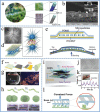The Evolution of Flexible Electronics: From Nature, Beyond Nature, and To Nature
- PMID: 33101851
- PMCID: PMC7578875
- DOI: 10.1002/advs.202001116
The Evolution of Flexible Electronics: From Nature, Beyond Nature, and To Nature
Abstract
The flourishing development of multifunctional flexible electronics cannot leave the beneficial role of nature, which provides continuous inspiration in their material, structural, and functional designs. During the evolution of flexible electronics, some originated from nature, some were even beyond nature, and others were implantable or biodegradable eventually to nature. Therefore, the relationship between flexible electronics and nature is undoubtedly vital since harmony between nature and technology evolution would promote the sustainable development. Herein, materials selection and functionality design for flexible electronics that are mostly inspired from nature are first introduced with certain functionality even beyond nature. Then, frontier advances on flexible electronics including the main individual components (i.e., energy (the power source) and the sensor (the electric load)) are presented from nature, beyond nature, and to nature with the aim of enlightening the harmonious relationship between the modern electronics technology and nature. Finally, critical issues in next-generation flexible electronics are discussed to provide possible solutions and new insights in prospective exploration directions.
Keywords: energy storage; flexible electronics; flexible sensors; functional designs; nature.
© 2020 The Authors. Published by Wiley‐VCH GmbH.
Conflict of interest statement
The authors declare no conflict of interest.
Figures



















Similar articles
-
Age of Flexible Electronics: Emerging Trends in Soft Multifunctional Sensors.Adv Mater. 2024 Apr;36(16):e2310505. doi: 10.1002/adma.202310505. Epub 2024 Feb 7. Adv Mater. 2024. PMID: 38258951 Review.
-
Materials, Structures, and Functions for Flexible and Stretchable Biomimetic Sensors.Acc Chem Res. 2019 Feb 19;52(2):288-296. doi: 10.1021/acs.accounts.8b00497. Epub 2019 Jan 17. Acc Chem Res. 2019. PMID: 30653299 Review.
-
Bio-inspired flexible electronics for smart E-skin.Acta Biomater. 2022 Feb;139:280-295. doi: 10.1016/j.actbio.2021.06.018. Epub 2021 Jun 23. Acta Biomater. 2022. PMID: 34157454 Review.
-
Naturally sourced hydrogels: emerging fundamental materials for next-generation healthcare sensing.Chem Soc Rev. 2023 May 9;52(9):2992-3034. doi: 10.1039/d2cs00813k. Chem Soc Rev. 2023. PMID: 37017633 Review.
-
Advanced Carbon for Flexible and Wearable Electronics.Adv Mater. 2019 Mar;31(9):e1801072. doi: 10.1002/adma.201801072. Epub 2018 Oct 9. Adv Mater. 2019. PMID: 30300444 Review.
Cited by
-
Revolutionary Point-of-Care Wearable Diagnostics for Early Disease Detection and Biomarker Discovery through Intelligent Technologies.Adv Sci (Weinh). 2024 Sep;11(36):e2400595. doi: 10.1002/advs.202400595. Epub 2024 Jul 3. Adv Sci (Weinh). 2024. PMID: 38958517 Free PMC article. Review.
-
Flexible thin film thermocouples: From structure, material, fabrication to application.iScience. 2023 Jul 10;26(8):107303. doi: 10.1016/j.isci.2023.107303. eCollection 2023 Aug 18. iScience. 2023. PMID: 37520735 Free PMC article. Review.
-
Fabrication of Cu Micromembrane as a Flexible Electrode.Nanomaterials (Basel). 2022 Oct 29;12(21):3829. doi: 10.3390/nano12213829. Nanomaterials (Basel). 2022. PMID: 36364606 Free PMC article.
-
A wearable electronic based on flexible pressure sensor for running motion monitoring.Discov Nano. 2023 Mar 1;18(1):28. doi: 10.1186/s11671-023-03788-7. Discov Nano. 2023. PMID: 36856874 Free PMC article.
-
Pinaceae Pine Resins (Black Pine, Shore Pine, Rosin, and Baltic Amber) as Natural Dielectrics for Low Operating Voltage, Hysteresis-Free, Organic Field Effect Transistors.Glob Chall. 2023 Sep 6;7(9):2300062. doi: 10.1002/gch2.202300062. eCollection 2023 Sep. Glob Chall. 2023. PMID: 37745829 Free PMC article.
References
-
- Lai Y. C., Deng J., Niu S., Peng W., Wu C., Liu R., Wen Z., Wang Z. L., Adv. Mater. 2016, 28, 10024. - PubMed
-
- Lee Y., Park J., Choe A., Cho S., Kim J., Ko H., Adv. Funct. Mater. 2019, 1904523.
-
- Boland J. J., Nat. Mater. 2010, 9, 790. - PubMed
-
- Meng B., Tang W., Too Z.‐H., Zhang X. S., Han M. D., Liu W., Zhang H. X., Energy Environ. Sci. 2013, 6, 3235.
Publication types
LinkOut - more resources
Full Text Sources
Other Literature Sources
